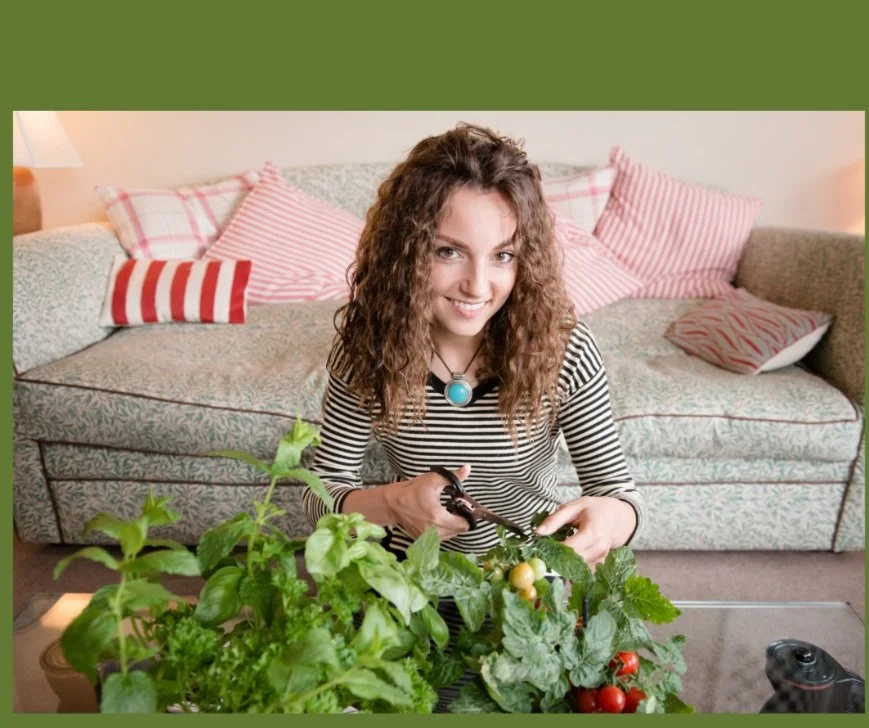We don’t always think about air circulation as being a critical component to raising vegetables and fruits indoors. When food plants are grown outdoors they are naturally exposed to wind and air currents. In addition, both plant leaves and roots need air moving around them.
Modern homes are built to eliminate drafts and control airflow so we are warm or cool according to the season. This does not necessarily mean there is good air circulation.
Why Is Air Circulation Important For Plants?
Air circulation is important above ground and below ground.
Plants need air (oxygen and carbon dioxide) to breathe and perform photosynthesis. Yes, static air is still air! However, circulation mimics the outdoor environment and dissipates the gases exhaled (the waste) by the plant.
Good indoor air circulation also decreases the likely hood of plant diseases caused by bacteria, fungus, and molds. In addition, it helps the plant regulate temperature by evaporating excess humidity.
Air circulation below ground helps the roots to grow and reach beneficial nutrients. It also helps the soil to drain well so excess moisture doesn’t sit around the roots. This causes the roots to suffocate and for disease organisms to flourish.
We help provide below-ground air circulation for our indoor plants by having a healthy light soil mix with perlite.
How Do You Increase Air Circulation?
Open windows
Place plants near windows
Use a fan
Place plants near vents
Make sure your home has a proper, well-maintained exhaust system
Provide adequate space in between plants
Hanging plants improves air circulation
Do Plants Need Air Circulation At Night?
Yes. During night time the plants stop photosynthesizing. During photosynthesis the plants release oxygen. However, when it is dark they reverse that process and take in oxygen and release carbon dioxide.
Before you panic that your plants release carbon dioxide know that it is a very tiny amount. Nothing that could cause animals and humans harm.
Good air circulation at night helps keep your plants healthy and growing.
Do Indoor Plants Need Fresh Air?
Fresh air is healthy for humans or plants unless you have severe allergies or live in a city with a high pollution index. Opening your windows and allowing air exchange can improve indoor air quality.
You can also place a window fan in one of your windows to help facilitate fresh air exchange. In the morning place it so air flows from the outside coming in. If the weather is warm send the air from the house outside.
Central AC
Central AC is often considered a godsend to those in the urban south where the air becomes quite hot and humid in the summer.
( I did live off-grid for 29 years in the south with no AC so it is doable!)
Central air conditioning has some drawbacks as far as your plants are concerned. It creates cold pockets in your home and can dry out the air. In the summer you may need to do some plant rearranging if plants are near a register.
HEPA Air Filters
When I moved from Kentucky to Wisconsin this past year my allergies became much worse given that I was around many new plants. I purchased two HEPA Air Filters.
I was pleasantly surprised to find that my plants seemed to benefit from them as well. They provide good air movement and have an added bonus. They reduce the smell when I fertilize or have a pathogen issue.
Do Fans Make Plants Stronger?
Yes, using fans on young plants mimics the wind they would encounter outside. This breeze helps to develop strong stems which leads to sturdy, healthier plants.
You don’t want to create a windstorm. A fan on a low setting about three feet from the seedlings is good. Do this for at least 10 minutes per day.
Author, Ame Vanorio, is the founder of Fox Run EEC and loves to be surrounded by plants.






Buying supplemental lights for your plants can be confusing. They come in a variety of colors - the spectrum color not the decor color - and a variety of lighting bulbs.
This guide will walk you through what all those different terms mean and how to figure out what type of light you need for what you plan to grow.